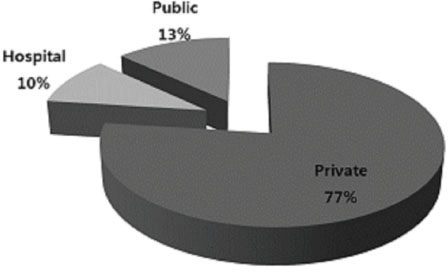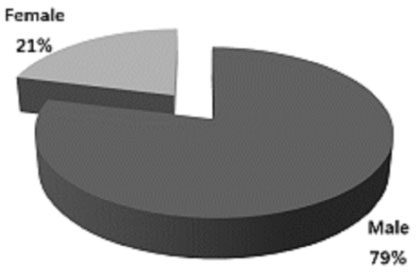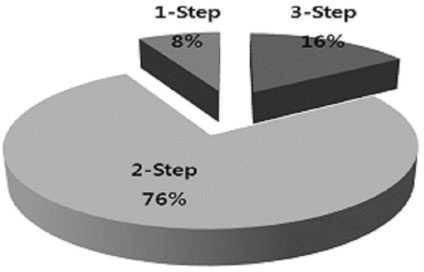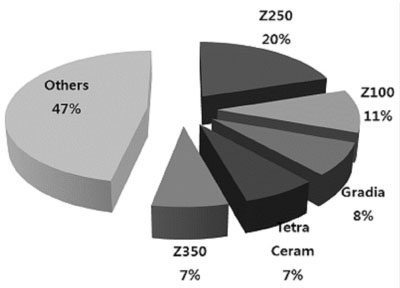J Korean Acad Conserv Dent.
2009 Mar;34(2):87-94. 10.5395/JKACD.2009.34.2.087.
A survey on the use of composite resin in Class II restoration in Korea
- Affiliations
-
- 1Department of Conservative Dentistry, School of Dentistry, Seoul National University, Seoul, Korea. hhson@snu.ac.kr
- KMID: 2294349
- DOI: http://doi.org/10.5395/JKACD.2009.34.2.087
Abstract
- The purpose of this study was to assess the current materials, methods and difficulties according to the year of licence and educational background of Korean dentists in Class II direct composite resin restorations. Total 17 questions were included in the questionnaire. Questions were broadly divided into two parts; first, operator's information, and second, the materials and methods used in Class II posterior composite restoration. The questionnaire was sent to dentists enrolled in Korean Dental Association via e-mail. Total 12,193 e-mails were distributed to dentists, 2,612 e-mails were opened, and 840 mails (32.2%) were received from respondents. The data was statically analyzed by chi-square test using SPSS(v. 12.0.1, SPSS Inc, Chicago, IL, USA). Male dentists among respondents was 79%. 60.3% of the respondents acquired their licences recently (1998-2007), and 77% practiced in private offices. 83.4% have acquired their knowledge through school lectures, conferences and seminars. For the Class II restorations, gold inlays were preferred by 65.7% of respondents, while direct composite resin restorations were used by 12.1% amalgam users were only 4.4% of respondents. For the restorative technique, 74.4% of respondents didn't use rubber dam as needed. For the matrix, mylar strip (53.4%), metal matrix (33.8%) and Palodent system (6.5%) were used. 99.6% of respondents restored the Class II cavity by incremental layering. Obtaining of the tight interproximal contact was considered as the most difficult procedure (57.2%) followed by field isolation (21%). Among various bonding systems, 22.6% of respondents preferred SE Bond and 20.2% used Single Bond. Z-250 was used most frequently among a variety of composite resins.
Keyword
MeSH Terms
-
Bisphenol A-Glycidyl Methacrylate
Chicago
Composite Resins
Congresses as Topic
Surveys and Questionnaires
Dentists
Electronic Mail
Humans
Inlays
Korea
Lectures
Male
Polyethylene Terephthalates
Postal Service
Rubber Dams
Surveys and Questionnaires
Bisphenol A-Glycidyl Methacrylate
Composite Resins
Polyethylene Terephthalates
Figure
Cited by 1 articles
-
Comparison of operative techniques between female and male dentists in class 2 and class 5 resin composite restorations
Juhea Chang, Hae-Young Kim, Ho-Hyun Son
J Korean Acad Conserv Dent. 2010;35(2):116-124. doi: 10.5395/JKACD.2010.35.2.116.
Reference
-
1. Wahl MJ. A resin alternative for posterior teeth: questions and answers on dental amalgam. Dent Update. 2003. 30(5):256–262.
Article2. Manhart J, Garcia-Godov F, Hickel R. Direct posterior restorations: clinical results and new developments. Dent Clin North Am. 2002. 46(2):303–339.
Article3. Melchart D, Vogt S, Kohler W. Treatment of health complaints attributed to amalgam. J Dent Res. 2008. 87(4):349–353.
Article4. Burke FJT, McHugh S, Hall AC, Randall RC, Widstrom E, Forss H. Amalgam and composite use in UK general dental practice in 2001. Br Dent J. 2003. 194(11):613–618.
Article5. Burke FJT, McHugh S, Randall RC, Meyers IA, Pitt J, Hall AC. Direct restorative materials use in Australia in 2002. Aust Dent J. 2004. 49(4):185–191.
Article6. Fontana M, Gonzalez-Cabezas C. Secondary caries and restoration replacement: an unresolved problem. Compend Contin Educ Dent. 2000. 21(1):15–18. 21–24. 267. Ortengren U. On composite resin materials. Degradation, erosion and possible adverse effects in dentists. Swed Dent J Suppl. 2000. (141):1–61.8. Deliperi S, Bardwell DN. An alternative method to reduce polymerization shrinkage in direct posterior composite restorations. J Am Dent Assoc. 2002. 133(10):1387–1398.
Article9. Sano H, Kanemura N, Burrow MF, Inai N, Yamada T, Tagami J. Effect of operator variability on dentin adhesion: students vs. dentists. Dent Mater J. 1998. 17:51–58.
Article10. Rabe P, Holmen A, Sjogren P. Attitudes, awareness and perceptions on evidence based dentistry and scientific publications among dental professionals in the country of Holland, Sweden. Swed Dent J. 2007. 31:113–120.11. Haj-ali RN, Walker MP, Petrie CS. Utilization of Evidence-based informational resources for clinical decisions related to posterior composite restorations. J Dent Educ. 2005. 69(11):1251–1256.
Article12. Lynch CD, McConnell RJ, Wilson NHF. Teaching the placement of posterior resin-based composite restorations in U.S. dental schools. J Am Dent Assoc. 2006. 137:619–625.
Article13. Mccomb D. Class I and Class II silver amalgam and resin composite posterior restorations: teaching approaches in Canadian faculties of dentistry. J Can Dent Assoc. 2005. 71(6):405–406.14. Peutzfeldt A, Vigild M. A survey of the use of dentin-bonding systems in Denmark. Dent Mater. 2001. 17:211–216.
Article15. Doméjean-Orliaguet S, Tubert-Jeannin S, Riordan PJ, Espelid I, Tveit AB. French dentists' restorative treatment decisions. Oral Health Prev Dent. 2004. 2(2):125–131.16. Brennan DS, Spencer AJ. Restorative service patterns in Australia: amalgam, composite resin and glass ionomer restorations. Int Dent J. 2003. 53(6):455–463.
Article17. Wilson NHF, Christensen GJ, Cheung SW, Burke FJT, Brunton PA. Contemporary dental practice in the UK: aspects of direct restorations, endodontics and bleaching. Br Dent J. 2004. 197(12):753–756.
Article18. Idriss S, Abduljabbar T, Habib C, Omar R. Factors associated with microleakage in Class II resin composite restorations. Oper Dent. 2007. 32(1):60–66.
Article19. Ghavamnasiri M, Moosavi H. Effect of centripetal and incremental methods in Class II composite resin restorations on gingival microleakage. J Contemp Dent Pract. 2007. 8(2):113–120.
Article20. Haj-ali R, Walker MP, Williams K. Survey of general dentists regarding posterior restorations, selection criteria, and associated clinical problems. Gen Dent. 2005. 8:369–375.21. Forss H, Widstrom E. From amalgam to composite: selection of restorative materials and restoration longevity in Finland. Acta Odontol Scand. 2001. 59(2):57–62.
Article22. Raskin A, Setcos JC, Vreven J. Influence of the isolation method on the 10-year clinical behaviour of posterior resin composite restorations. Clin Oral Investig. 2000. 4:148–152.
Article23. Fusayama T. Total etch technique and cavity isolation. J Esthet Dent. 1992. 4:105–109.
Article24. Park JG, Lim BS, Lee IB. Cuspal deflection in class v cavities restored with composite resins. J Korean Acad Conserv Dent. 2008. 33(2):83–89.
Article25. Koo BJ, Shin DH. The effect of c-factor and volume on microleakage of composite resin restorations with enamel margins. J Korean Acad Conserv Dent. 2006. 31(6):452–459.
Article26. Cho YG, Kim MH, Lee MG. Effect of resin sealants on the reduction of microleakage in composite restorations. J Korean Acad Conserv Dent. 2006. 31(4):282–289.
Article27. Nakabayashi N, Kojima K, Masuhara E. The promotion of adhesion by the infiltration of monomers into tooth substrates. J Biomed Mater Res. 1982. 16:265–273.
Article28. Munck JD, Landuyt KV, Peumans M, Meerbeek BV. A critical review of the durability of adhesion to tooth tissue : Methods and results. J Dent Res. 2005. 84(2):118–132.
Article29. Peumans M, Kanumilli P, Munck JD, Meerbeek BV. Clinical effectiveness of contemporary adhesives : A systematic review of current clinical trials. Dent Mater. 2005. 21:864–881.
Article30. Munck JD, Meerbeek BV. One-day bonding effectiveness of new self-etch adhesives to bur-cut enamel and dentin. Oper Dent. 2005. 30:39–49.31. Shirai K, Munck JD, Yoshida Y, Meerbeek BV. Effect of cavity configuration and aging on the bonding effectiveness of six adhesives to dentin. Dent Mater. 2005. 21:110–124.
Article32. Yoshida Y, Meerbeek BV. Comparative study on adhesive performance of functional monomers. J Dent Res. 2004. 83:454–458.
Article
- Full Text Links
- Actions
-
Cited
- CITED
-
- Close
- Share
- Similar articles
-
- Comparison of microleakage after load cycling for nanofilled composite resin fillings with or without flowable resin lining
- Survival Rates of Class II Restoration in Primary Molar with Flowable Resin Composite
- Influence of flowable composite lining on microleakage at the gingival dentin margin
- Repair Rate of Composite Resin Restorations in Permanent First Molar in Children Under 12 Years Old
- A 3-year retrospective study of clinical durability of bulk-filled resin composite restorations





